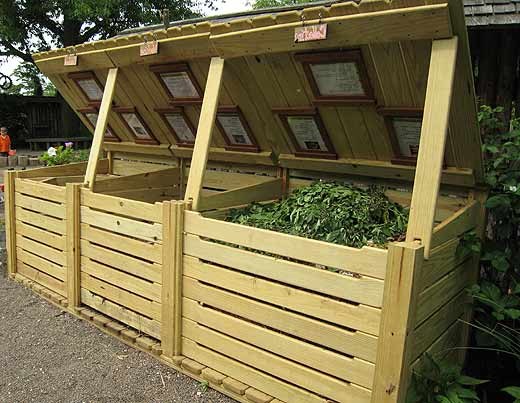Device the compost pit
Device the compost pit depends largely on the aims with which she created. If you have no place to put organic garbage, and after a couple of years you would like to obtain the most valuable fertilizer for the plants, then the hole can make for a very simple scheme.
To do this, dig a pit depth of two feet and the same width. Hostelite bottom weeds, plant residues and dry leaves. Food waste can be put in the hole and cover with prepared with dry leaves. In this case, you do not risk to plant in the garden flies, prevent the formation of unpleasant odors.
Select for the organization of the pit is a place that will not be evident.
The usefulness of the compost pit
The useful properties of compost are quite large. All the nutrients are not in the form of organic soluble salts and a kind of connection with organic matter. They are not washed away with watering and rain into the deeper soil layers always remain in the upper layer of the earth, where are concentrated and plant roots. Compost enriched with humus and essential trace elements, for the earth is a beautiful mulch, which suppresses weed growth and retains moisture. A special advantage of the compost pit – ease of production.
Remember that a compost pit is not indiscriminate dumping of waste, and a kind of structure that has to be done according to strict rules.
The composition of the compost pit
The compost can go to the following household waste: raw fruits, vegetables, tea, coffee and cereals; residues of prepared food; straw and hay; meat waste; shredded wood; ash; fresh and rotted manure agricultural herbivores; natural paper in powdered form.
They also include garden waste, shredded branches, bark, wood and roots; thin branches after icons of shrubs and trees; mowed with lawn grass; young weeds; freshwater or marine algae; polupereprevshie last year's leaves; other organic waste.
It is very important to correctly alternate the products that are provided in a compost pit. The main principle is that the green layers (soft and wet) need to be alternated with the brown (hard and dry). On vegetable or fruit layer, place a layer shredded paper, then a small layer of grass, then a layer of annuals and last year's leaves.
You can not put in a compost pit: plastic bottles and iron cans; solid and large meat bones; charcoal; waste after the use of herbicides, perennial and rhizomatous flowering weeds; the dry leaves of the current year; affected by pests and diseases waste.
